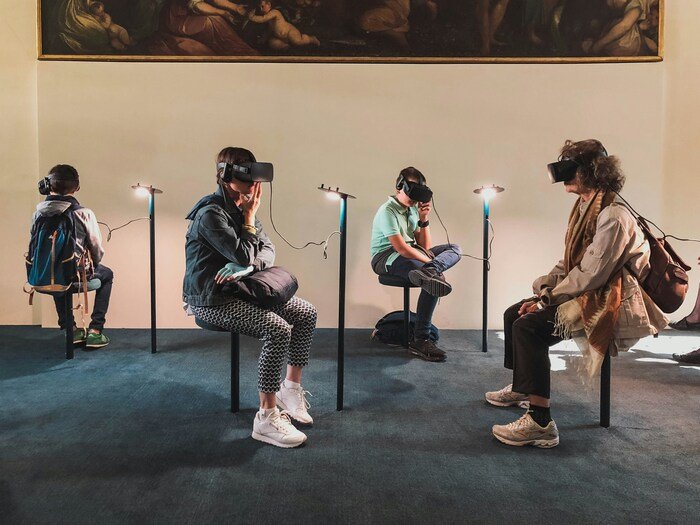Vatican Museums Ladder by Michele Bitetto
Are you still wondering if AI (Artificial Intelligence) is a tech buzzword or an actual solution for cultural spaces? You're not the only one.
Maybe you've heard that AI can transform visitor experiences but aren't quite sure what that looks like in practice. Many museum directors, zoo managers, and heritage site administrators are on the fence, unsure whether to dive in or stay on the sidelines. Let's face it: nobody wants to waste time or resources on empty promises.
Back in the day, museums were initially hesitant about going digital. The idea of organizing collections, exhibitions, and user data virtually seemed daunting and unnecessary - but we all now see how big of an asset technology actually is. This digital shift didn't just streamline operations; it revolutionized how staff and visitors interacted with museum resources.
Today, those pioneering efforts have blossomed into projects like Google Arts & Culture, social media profiles dedicated to art and culture, and a huge audience interest in in-person experiences. The leap to digital opened up a world of possibilities, demonstrating that innovation can lead to extraordinary outcomes.
But what if AI could actually make your visitors' experiences unforgettable? Imagine AI applications in museums recommending exhibits like a personal guide or smart systems translating information in real-time for international guests.
Let’s unlock the future and understand best the game-changing world of AI innovations that are set to revolutionize cultural spaces, enhancing accessibility, visitor engagement, and data management like never before.
1. Personalize Visitor Experiences
Museu do Amanhã, Rio de Janeiro by Marcelo Martins Teixeira
Part of Generative AI's core magic is making everything feel super customized. It can tailor content based on individual preferences and predict exactly what each visitor seeks. Does Visitor A love Renaissance art? The app directs them straight to the masterpieces. Do they prefer history? It highlights the most intriguing artifacts.
Take the Museu do Amanhã, or Museum of Tomorrow, in Rio de Janeiro, Brazil, Since its opening in 2015, it successfully launched IRIS, a digital assistant operated through a chipped card that gathered visitors' personal data and personalized their experience as they toured the main exhibit. IRIS would know which sectors remained unvisited and store this information for future visits, creating recommendations and sending updates to users via the internet.
Then, the Museum of Tomorrow partnered with IBM and launched IRIS+ in 2017, a cognitive assistant built with IBM Watson, hosted at IBM’s Cloud, and trained with the participation of IRIS users (yes, from the IRIS database!). While IRIS+ is also mediated by the cards, it speaks to people, formulates questions, and connects them to initiatives related to their primary social or environmental concerns.
Read more about the experience of developing IRIS+:
The impact is huge for visitors, who feel more connected and engaged, even inspired to build a better tomorrow for our planet, and for staff, who can, thanks to technology, focus exclusively on understanding people's needs and offering punctual and effective solutions that strengthen the human bond.
2. Enhanced Accessibility for All Visitors
Image created by Igor Omilaev
Everyone should have access to cultural knowledge. AI-powered solutions can provide many solutions to bridge the gap between cultural knowledge and people.
For example, the International Council of Museums (ICOM) is implementing multilingual voice-overs for its articles. The feature plays a key role in amplifying digital engagement by harnessing the power of Generative AI.
Here at Cuseum, we can help you reach your accessibility goals faster than ever with our AI-powered Language Translation and Text-to-Speech features. These features allow you to create and offer multilingual content seamlessly and accurately, both in text and audio. This is a win-win AI tool that will allow organizations like yours to broaden their scope and offer richer experiences for everyone.
3. Amplifying Digital Engagement Through Education
Máximo at the Field Museum
Learning should be embedded in the fiber of cultural organizations. AI applications in museums truly help make educational programs more engaging, dynamic, and even global.
For example, in 2017, the Ann Frank House in the Netherlands integrated a chatbot through Meta's Messenger platform that offered personalized and immediate answers about Anne Frank, her family, diary, and time.
In 2019, the Field Museum in Chicago created an AI-driven messaging service for people to interact with Máximo, the largest dinosaur ever to exist, and solve any dinosaur-related doubt with the clear imprint of Máximo's personality and unique language traits.
The result? A permanent presence that can motivate future visits, offer relevant data to the institution, and increase awareness on a topic worldwide. This level of engagement transforms passive observation into active participation, making knowledge stick.
4. Visitor Feedback and Adaptation
Tourists at the British Museum by Tamara Menzi
Feedback is crucial, but processing large amounts of data from social review platforms like TripAdvisor or Google Maps comments and ratings can be a daunting task. Not to mention that it can't be done any faster than the human eye can read—which is also not on a 24/7 basis.
AI changes the game by collecting and analyzing visitor feedback in real-time, allowing for faster improvements. The best part? Staff can focus on more creative and purposeful initiatives while the machines do the heavy lifting.
For example, the British Museum has piloted a system thanks to a partnership with the Alan Turing Institute, which uses AI to gather and manage information contained in emails, comment cards, online reviews, and Wi-Fi access.
The impact is a more responsive and visitor-centered environment. Continuous improvement becomes the norm, constantly enhancing museum experiences.
5. Predictive Analytics for Future Trends
The National Gallery by Roman Akash
Understanding visitor trends is key to optimizing operations and marketing efforts. AI’s predictive analytics can analyze visitor patterns to forecast attendance and preferences, offering valuable insights.
For example, the National Gallery in London has been developing custom-built predictive models to understand variables like how many people can comfortably fit within a gallery, what time slots and days will be busy or quiet, and even what type of people will visit the exhibition. All this by training a model using data from over twenty years of exhibition history! The results are available for any employee to access and constantly updated.
The benefits are clear: highly efficient resource allocation and targeted marketing efforts to drive higher visitor numbers and engagement, not to mention that the creative teams will have a clear focus on developing new ideas.
6. Collection Management
The Metropolitan Museum of Art by Stephen H
Having controlled and structured data is a top priority for any institution. AI Applications in museums offer advanced techniques for classifying and tagging artifacts, ensuring everyone can access them.
For example, the Metropolitan Museum of Art (The Met) in New York has more than half a million digitized records, but they lack information or tags that could help people find a specific piece online easily.
By partnering with Microsoft and the Massachusetts Institute of Technology (MIT) to develop five prototypes of how AI could get people closer to art. One of them was Tag, That's It! A crowdsourcing initiative to help the AI understand images so someday it can tag them by itself.
The impact is having a much more accessible collection that's highly searchable and shareable. Thankfully, no one will have to create manual tags for the 1.5 million artworks The Met has in its permanent collection.
What About the Implications of AI?
While AI offers countless opportunities for enhancing cultural experiences, amplifying digital engagement, and simplifying task management, it also raises ethical concerns that institutions must navigate carefully. Let's consider data management and privacy or cultural biases that can lead to unexpected or unacceptable issues.
This discussion is necessary and healthy for the advancement of AI-powered solutions in daily operations at any organization. Balancing innovation with responsibility is key to ensuring that AI serves as a tool for inclusion and development rather than exclusion or harm.
Learn more about Ethics & AI Applications:
Embrace the Future of Cultural Engagement
Picture by Lucrezia Carnelos
Maybe you’re thinking, "This sounds incredible, but is it really for us?" or "Can we actually pull this off?" Those thoughts are valid. Many institutions are at this very crossroads or at the very early stages, wondering how to take the next step.
Here’s the thing: AI is here now. This isn’t just about keeping up with technology; it’s about creating moments that resonate with your audience, fostering connections that last long after they've left your doors, and finally being able to focus human touch and intelligence into more profound developments.
Every day, we move one step closer to unlocking the future and enhancing museum experiences and visitor engagement through the use of new technologies like AI.
Check out these related articles, learn more about this exciting topic, and Cuseum’s take on it over the years:
Get to know the broad range of digital solutions we have at Cuseum to foster visitor engagement and strengthen your connection with your audience.








